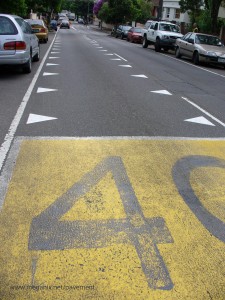 Now here’s a colourfully interesting grouping of pavement and close-to-pavement graffiti in Enmore. A gnomish amputee in paper, a soda siphon stencil, a cement cast – presumably by guerrilla artist Numb – and mauve crowns and circles. Mauve is an unusual colour for pavement graffiti and not particularly distinct on the mottled concrete. Did Numb add these embellishments to his own work or was the violet (not violent) spray-painter an admirer who came along afterwards?
Now here’s a colourfully interesting grouping of pavement and close-to-pavement graffiti in Enmore. A gnomish amputee in paper, a soda siphon stencil, a cement cast – presumably by guerrilla artist Numb – and mauve crowns and circles. Mauve is an unusual colour for pavement graffiti and not particularly distinct on the mottled concrete. Did Numb add these embellishments to his own work or was the violet (not violent) spray-painter an admirer who came along afterwards?
Admiration of manhole covers became a popular pastime in the 1990s.  Mimi and Robert Melnick’s 1974 Manhole covers of Los Angeles has become a collectors item, but their 1994 book Manhole covers and Jacopo Pavesi and Roberta Pietrobelli’s 2001 book Street covers brought cast-iron style to the coffee table. The minor mania for manhole covers has culminated in book titles ranging from Designs underfoot: the art of manhole covers in New York City to Quilting with manhole covers: a treasure trove of unique designs from the streets of Japan.
In picture books the manhole covers are brushed up for the camera, but like Japanese artist Genpei, I prefer the look of them in their natural state, with cigarettes and Smarties and tsubo gardens of moss, grass or weeds nestling in their grooves.
Â
My very favourites are the pretend manhole covers that mark the place of the real thing when a road is being resurfaced.
I also love the website Misplaced Manhole Covers.
Rows of triangular marks have just been planted on roads in the Inner West. I had to do a bit of research to find out that they are Dragon’s Teeth. To date no fully armed warriors have sprung from the asphalt.
The lexicon of official road signs continues to grow. The rollout of this latest addition apparently began in mid-2009, when the RTA’s press release was dutifully rendered as a news story in the Sydney Morning Herald. These triangular markings are meant to indicate to motorists that they are entering a 40 kmh school zone.
The indignant Mr Peter Olsen, on his School Zone Santa.Com blog, reckons that “the Government has completely lost the plot on school zones. Static markings, including the proposed new ‘dragon’s teeth’ achieve nothing because they do not distinguish between school zone hours and non-school zone hoursâ€, whereas if the school zone instead has flashing lights during the relevant hours “drivers are instantly reminded and can slow down, but then of course the Government can no longer collect speeding fine revenue from themâ€.
Note to apostrophe pedants: Dragon’s Teeth is the official New South Wales Government term for these road marks (see Technical Direction TD 2009 SR02). There is only one dragon involved. It is a particular toothy dragon.
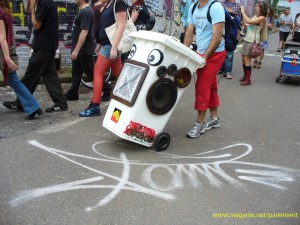 If they won’t let you Reclaim the Streets any more, then Reclaim the Lanes instead. It’s a bit sad really. The RTL party on 13 February was small but kind of fun anyway, even if everyone was funnelled into just one lane not far from the starting point. There were balloons, bikes, and budgie smugglers. When it became apparent that the procession had come to a halt people started sloping off to the bottlo in Enmore Road for supplies. The music from wheelie bin sound systems was great. And someone stuck up their photographs of the Reclaim the Streets events in Newtown from 1999 and 2000 to remind everyone what it used to be like.
If they won’t let you Reclaim the Streets any more, then Reclaim the Lanes instead. It’s a bit sad really. The RTL party on 13 February was small but kind of fun anyway, even if everyone was funnelled into just one lane not far from the starting point. There were balloons, bikes, and budgie smugglers. When it became apparent that the procession had come to a halt people started sloping off to the bottlo in Enmore Road for supplies. The music from wheelie bin sound systems was great. And someone stuck up their photographs of the Reclaim the Streets events in Newtown from 1999 and 2000 to remind everyone what it used to be like.
The back lanes of Enmore and Newtown are best known for their wall art, but there is stuff on the ground as well, mostly the signatures of artists who have done the wall pieces. I took photographs of RTL participants partying on the remnants of old pavement graffiti.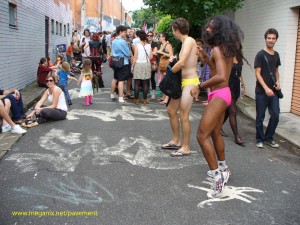
Today’s guest spotter is Richard Blair, a local history fossicker.
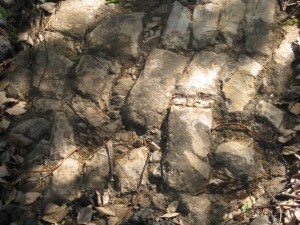 Recently uncovered by Marrickville Council during street plumbing activity under two Camphor Laurel trees on the eastern side of upper Metropolitan Road, Enmore, Sydney, are what appear to be sandstone cobblestones.
Recently uncovered by Marrickville Council during street plumbing activity under two Camphor Laurel trees on the eastern side of upper Metropolitan Road, Enmore, Sydney, are what appear to be sandstone cobblestones.
One expert opinion suggests these stones may have been part of a carriageway as they are in such a deliberate order. That would mean they may be linked with Enmore House which formerly stood on this site until demolition in the 1880s. However, one might expect a cobblestone carriageway to have been made from a stone more durable than sandstone, such as granite or bluestone.
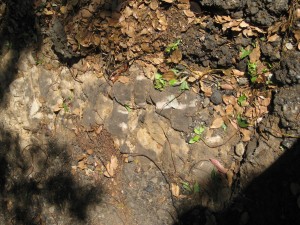 Other views suggest the sandstone course may have been associated either with some early civil works project or may have been laid in conjunction with the arrangement of street tree planting.
Other views suggest the sandstone course may have been associated either with some early civil works project or may have been laid in conjunction with the arrangement of street tree planting.
These photos were taken in September 2009. The sandstone courses were still uncovered in November, but by December 2009 they had been (presumably) covered over with soil.
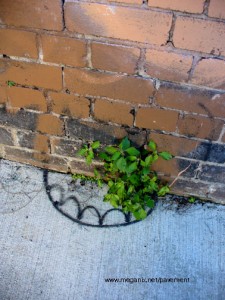
A thoughtful graffitist provided a decorative fence for this little garden of asthma weed near Piss Alley in Enmore. To see another tiny nurtured garden, check out Darlinghurst Nights.
Elsewhere in Enmore, pavement degeneration around a cast iron alignment pin has created a niche for a weedlet garden. Many thanks to PC for his enthusiastic explanation of alignment pins, which indicate where the surveyed kerb line is. For me, official pavement embellishments such as hydrants, manhole covers, and the various kinds of alignment posts, pins and stones, can be enjoyed for their aesthetic qualities or read like an archive of urban development.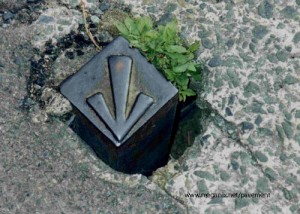
Â
Â
Â
Â
Â
Â
Â
Â
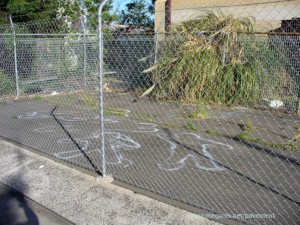
 A remnant of the playground or parking lot at what used to be Enmore Boys High School, now a fenced-off piece of waste ground. The scene of a massacre? No – probably somebody practising with ‘body outline’ shapes. But why? And why here?
The body outline is a crime fiction cliché. In real life police hardly ever draw around corpses but the image is used by everyone, from advertisers to political protestors, to signify some sort of violent death. There are more pavement bodies in an article I wrote for on-line journal Second Nature – ‘Outlines (Watch this space)’Â
Hicks, M. 2009. Outlines (Watch this space). Second Nature 1 (1):124 – 139.



